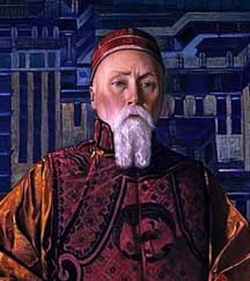Shambhala Warrior in a Western Body: Nicholas Roerich’s Asian Ventures
In the spring of 1924, the Reds, previously viewed as nothing more than the servants of Satan, suddenly turned into allies. Nicholas and Helena Roerich realized that the success of their plan to build their Sacred Union of the East needed backing by one of the great powers in the area. Red Russia was their choice: what if they linked their project to the Bolsheviks’ attempts to stir national liberation in the East? Besides, Nicholas did not like the British anyway because they had been trying to disrupt his attempts to enter Tibet. Their teacher Morya blessed this political turnaround: “Now business needs to be done with the Bolsheviks.”1
Soon, the master unveiled the following political itinerary for the couple: “A trip to Moscow, where the one who will come from the East will be received with honors. From there, he will travel to Mongolia. In the middle of 1926, you can be in Mongolia in the center of the Orient, since, from now on, this country is the center.” A! er receiving these revelations, Helena noted in her diary, “Now everything has changed. Lenin is with us.”2
Inspired by this new turn of events, Nicholas Roerich did not stay in India for long. Leaving his wife in Darjeeling, he and George rushed to Europe, where they showed up at the gates of the Soviet embassy in Berlin and were welcomed by Nikolai Krestinsky, Bolshevik ambassador to Germany. Roerich began by explaining that he was planning an expedition to Inner Asia to paint local landscapes and do some archaeological digs. Since the envisioned route would go through southern Siberia and Mongolia, the painter needed Soviet diplomatic and logistic backup. In exchange, Roerich volunteered to promote the Bolshevik cause and to gather intelligence information on British activities in the area. Like his idealistic comrades, Krestinsky lived in expectation of the world Communist revolution—the Marxist second coming.
Well aware of this revolutionary prophecy, Roerich readily massaged the diplomat’s Bolshevik ego. In Tibet and in the caves of the Himalayas, the painter con" ded, hundreds of thousands of Hindu mahatmas and Buddhist lamas looked with hope to Red Russia. All these people, Roerich continued, circulated militant prophecies and preached the triumph of communism, for it matched the ancient teachings of Buddha, who had advocated equality and communal living. ? ese Oriental folk hated the British and were eager to join the Bolshevik cause.
Roerich also played on the Bolsheviks’ anti-England paranoia, exaggerating British activities in Tibet: “? e occupation of Tibet by the English continues uninterrupted. English troops in" ltrate the area by small groups, using all kinds of excuses.”3 In reality, there was no English occupation of Tibet or of any other area north of the Himalayas. In fact, the thirteenth Dalai Lama skillfully played one great power o# another and did not allow anyone to make inroads into his theocracy.The cost-saving British never actually planned to take over the Forbidden Kingdom, even during their 1904 invasion of Tibet. Their goal was to open up the country for trade and keep it as a territorial cushion between India and Russia/China.
Haunted by the specter of the British threat and lacking reliable information about Inner Asia, Bolshevik diplomats were susceptible to Roerich’s blu# . In fact, before the painter visited the Soviet embassy in Berlin, Georgy Chicherin, Bolshevik Commissar for Foreign A# airs, was already convinced that Tibet was almost a colony of England. Satis" ed with the talk, Krestinsky promised to support Roerich and immediately sent a report to Chicherin, knowing that his Anglophobe boss would be pleased. Before the two parted, they agreed that Roerich would send intelligence briefs and sign them using the alias Ak-Dorje, which means “White Hard Arrow” or “White Hard Lightning” in Tibetan. Chicherin became excited and wrote back to Berlin, stressing that through Roerich Red Russia could get a foothold in Tibet: “Dear comrade, please do not lose from sight that half-Buddhist and half-Communist you wrote me about earlier. So far we have not had such a good bridge to these important centers.
Under no circumstances should we lose such an opportunity. How we are going to use this opportunity, however, will require very serious consideration and preparation.”4 In October 1924, the painter and his son stunned their American associates by suddenly resurfacing in New York and announcing that from then on the Bolsheviks should be treated as comrades. Roerich also revealed he was planning to take a land concession in the Altai in southern Siberia, o$ cially for mining and agricultural purposes, but actually he planned to set up the capital of his Sacred Union of the East in this area. Krestinsky was not Roerich’s only Bolshevik contact.
On the way to New York, he had stopped in Paris where he met Leonid Krasin, a Bolshevik ambassador to France, and discussed with him the Altaian concession. Back in the United States, the painter got in touch with Dr. Dmitri Borodin, a plant physiologist and rather shady character whom the painter and his friends nicknamed Uncle Boris. A! er the Bolshevik revolution, Borodin moved to the United States, where he represented the Soviet Commissariat for Agriculture. A few years later he became an immigrant, working " rst as a zoology instructor at Columbia University and then as a researcher in a biology laboratory in Cold Spring Harbor, New York. A well-rounded but very unscrupulous individual, Borodin served as Roerich’s Bolshevik liaison, helping the painter stay in touch with Soviet diplomats in Montreal, Paris, Berlin, and Moscow. Uncle Boris not only assisted Roerich in securing the concession in Altai; he also became involved in his Great Plan.It appears that through Borodin, Roerich tried to probe how the Bolsheviks would react to his scheme to blend Tibetan Buddhism with
